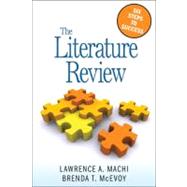
| Preface | p. ix |
| Audience | p. ix |
| Special Features and Text Organization | p. x |
| Acknowledgments | p. xiii |
| About the Authors | p. xv |
| Introduction: The Literature Review Process-Getting Started | p. 1 |
| The Purpose of a Literature Review | p. 2 |
| The Literature Review Defined | p. 4 |
| The Literature Review Process | p. 4 |
| Select a Topic | p. 4 |
| Search the Literature | p. 5 |
| Develop the Argument | p. 5 |
| Survey the Literature | p. 6 |
| Critique the Literature | p. 6 |
| Write the Review | p. 6 |
| Inquiry: The Necessary Precondition | p. 6 |
| Pack Wisely Before You Begin | p. 8 |
| Tips | p. 10 |
| Summary | p. 10 |
| Checklist | p. 11 |
| Select a Topic | p. 13 |
| Choose a Research Interest | p. 16 |
| Exercises | p. 18 |
| Researcher Bias | p. 19 |
| Select a Research Interest From the Everyday Interest | p. 20 |
| Specifying a Research Interest | p. 21 |
| Focusing the Interest | p. 22 |
| Selecting a Perspective | p. 22 |
| Reflection: The Key to Interest Selection | p. 23 |
| Use the Research Interest to Choose the Research Topic | p. 26 |
| Visit the Library | p. 30 |
| Tips | p. 32 |
| Summary | p. 32 |
| Checklist | p. 33 |
| Search the Literature | p. 35 |
| Discover the Literature to Review | p. 36 |
| Conduct a Literature Search | p. 37 |
| Scan the Literature | p. 39 |
| Use the Internet | p. 42 |
| Manage Your Data | p. 44 |
| Bibliographic Documentation | p. 44 |
| Scan Progress | p. 45 |
| Skim the Literature | p. 46 |
| Map Your Materials | p. 48 |
| Mapping by Core Idea | p. 49 |
| Mapping by Author Contribution | p. 50 |
| Refine Your Topic | p. 53 |
| Expand Your Topic | p. 55 |
| Tips | p. 56 |
| Summary | p. 56 |
| Checklist | p. 57 |
| Develop the Argument | p. 59 |
| Build the Case for a Literature Review | p. 60 |
| Arguments | p. 62 |
| Evaluate the Basic Parts of an Argument | p. 62 |
| Claims | p. 65 |
| Claims | p. 65 |
| Evidence | p. 70 |
| Warrant | p. 74 |
| Multiple Claims Arguments | p. 76 |
| Tips | p. 78 |
| Summary | p. 78 |
| Checklist | p. 79 |
| Survey the Literature | p. 81 |
| Assemble the Collected Data | p. 82 |
| Assembling the Data | p. 82 |
| Recording the Data | p. 83 |
| Synthesize the Information | p. 85 |
| Synthesizing the Information and Building Evidence | p. 85 |
| Reasoning Patterns | p. 88 |
| Integrating the Information and Building Claims | p. 92 |
| Analyze the Patterns of the Data | p. 94 |
| Complex Reasoning | p. 94 |
| Comparative Reasoning | p. 96 |
| Building the Discovery Argument: An Example | p. 97 |
| Mapping the Argument of Discovery | p. 99 |
| Analyzing the Argument | p. 99 |
| Tips | p. 101 |
| Summary | p. 102 |
| Checklist | p. 103 |
| Critique the Literature | p. 105 |
| Implicative Reasoning | p. 106 |
| The Two Arguments | p. 107 |
| Argument Patterns | p. 110 |
| Backing | p. 116 |
| Fallacious Arguments | p. 122 |
| The Case Is Everything | p. 124 |
| Tips | p. 124 |
| Summary | p. 125 |
| Checklist | p. 125 |
| Write the Review | p. 127 |
| The Writing Process: Overview | p. 129 |
| Write to Understand | p. 129 |
| Write to Be Understood | p. 129 |
| Write to Understand | p. 130 |
| Exploratory Writing | p. 131 |
| Outline | p. 133 |
| The Preliminary Draft | p. 143 |
| Preliminary Draft: The Audit | p. 145 |
| Preliminary Draft: The Edit | p. 146 |
| Write to Be Understood | p. 146 |
| Analysis | p. 148 |
| Evaluation | p. 148 |
| Outside Review | p. 149 |
| The Second and Third Drafts | p. 150 |
| The Final Draft | p. 151 |
| Style Manuals | p. 151 |
| Tips | p. 153 |
| Last Words | p. 153 |
| Glossary | p. 155 |
| References | p. 159 |
| Index | p. 161 |
| Table of Contents provided by Ingram. All Rights Reserved. |
The New copy of this book will include any supplemental materials advertised. Please check the title of the book to determine if it should include any access cards, study guides, lab manuals, CDs, etc.
The Used, Rental and eBook copies of this book are not guaranteed to include any supplemental materials. Typically, only the book itself is included. This is true even if the title states it includes any access cards, study guides, lab manuals, CDs, etc.